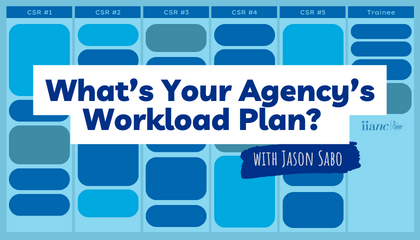What's Your Agency's Workload Plan?
November 17, 2022 Jason Sabo, TRAOne of the biggest barriers to growth that I see in agencies is not having a workload and services plan for their employees to follow. An agency without this plan usually looks like agency owners bouncing from task to task, producers struggling to track their accounts, and CSRs having large ups and downs in the demands of their workloads. Not only is this agency structure not sustainable, but it does not allow your agency to grow its book of business, train new staff effectively, or track your revenue, employee bandwidth, and efficiencies.
The solution to this type of agency structure can be overwhelming for agency owners to tackle, but once you get the process started it will allow you to take your agency from an everyday scramble to an organized, well-functioning machine. I have helped many agencies of various sizes through this process. The result has not only allowed the agency owner to have more free time in their day but has also allowed the agency to grow.
Step 1: Get on Board
The first step to this process is to get your entire agency on board from the top level down. This change is going to involve the entire organization. You can’t do this process halfway; once you start the process of organizing your agency’s workload, you must fully commit, or your agency will still be operating with an everyday scramble.
Step 2: Identify Your Agency’s Operational Benchmarks
The next step is to find what operational benchmarks your agency should be operating on compared to others. Many things can be a factor in your agency’s benchmarks, but the most common things to look at are revenue and the number of accounts compared with other agencies in your area that are the same size, same structure and have the same number of staff. This will give you a good idea of where you stand in comparison to other agencies, therefore giving you your operational benchmarks. There are a lot of moving parts to this step, if you need help, please feel free to reach out to me!
Step 3: Organizing Accounts
After you have determined the benchmarks that your agency should be striving to operate on, the next step is to inventory your current accounts. The easiest way to do this is to have your staff make a list of all the accounts they have in their books and then make a list of the house accounts that aren’t tied to any specific person.
Now is the part that will make the world of difference in your agency: organize your accounts so that each of your CSRs and producers have a relatively equal amount of client revenue and workloads. There are two VERY important things to consider as you are reorganizing clients:
Existing relationships between CSRs or Producers and the clients that are too strong to move.
The size and needs of each client.
Taking these two factors into account will help you determine which accounts need to stay where they are and will help you balance accounts between your employees. This step is like putting a puzzle together that is made up of each of your clients.
Here is a visual representation of what I mean when I say to organize the accounts so that each CSR has a relatively equal amount of client revenue and workload with clients. In this example, each column represents a CSR and their client roster which is represented by the different sized and colored blocks. The larger the block, the larger the client/needs of the client. Each client is colored by what type of client they are to the CSR. The light blue blocks are clients that CSRs have strong relationships with so they cannot be moved, blue blocks are clients who are able to move onto someone else's service, and grey squares represent house accounts.
This visual representation of the process also has an example for the workload you would assign a trainee. While there is a whole other article I can (and probably will be) writing in the future, I thought it was important to display this here. Someone new to your team should start with small accounts that can be easily transferred, as they are great people to work on house accounts. While you’re still building your employee onboarding process, this is important to remember (more to come on onboarding processes soon!)
Step 4 (Optional): Implement Technology
An optional next step that I have worked into this process is to implement technology and automations wherever you can. Creating automation to guide the client's experience can help free up your staff bandwidth and workload. Previous clients have added automation that funneled house accounts into CSR’s client books, then added an incentive strategy for cross-selling to the CSR or have added other automations such as annual billing reminders, customer onboarding, and claims processing.
Step 5: Make the Change
The last part of this process is to make the change. Your employees will be building new relationships with the clients in their books. There may be growing pains at first, but this process will pay off in the end. One tip that I give clients here is to make sure that the service they’re getting is the same throughout the entire agency. When a current or potential client calls your office, you want to be sure that no matter who they are talking to they will receive the same level of customer service.
If I can be of any help to you in this process, please let me know! I would love to help you balance your agency’s workload to give your agency the opportunity to grow. If you are an IIANC member and have not used your one hour of free consulting, schedule your time with me now!
Cowritten with Lindsay Wallace


/jason-saboe6164ef7-fcd7-41f8-a07b-6e503edd8547.png?sfvrsn=d1c4fea0_1) Jason Sabo, TRA
Jason Sabo, TRA